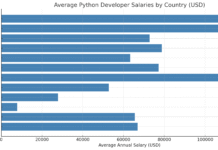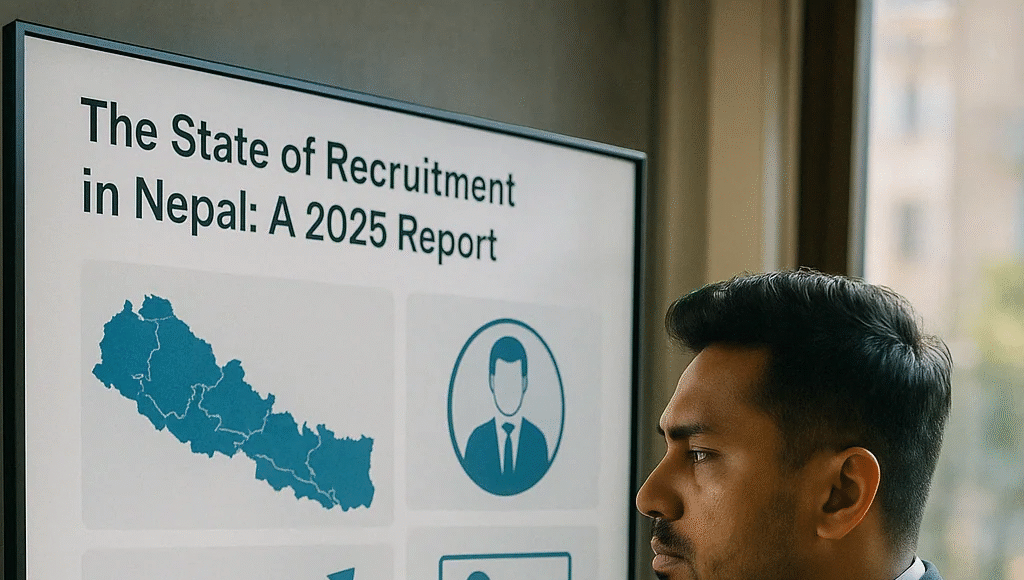Key Takeaways
- The IT sector is expected to drive significant job growth in Nepal by 2025, with high demand for technical skills in AI, cloud computing, and data science.
- Recruitment in Nepal is increasingly shifting to digital platforms, with employers embracing AI-driven tools and online job portals to streamline hiring processes.
- Challenges such as skills mismatch, brain drain, and a competitive job market highlight the need for upskilling initiatives and strategic employer branding.
In recent years, Nepal’s job market has undergone significant shifts, driven by rapid technological advancements, evolving workforce expectations, and broader economic developments.
As we step into 2025, understanding the current state of recruitment and hiring in Nepal has never been more critical for businesses, job seekers, and policymakers alike.
This report aims to provide a comprehensive overview of Nepal’s employment landscape, offering insights into emerging trends, challenges, and opportunities shaping the future of work in the country.

Nepal’s recruitment and hiring processes have traditionally been influenced by a mix of socio-economic factors, educational structures, and cultural norms.
However, the post-pandemic recovery, digital transformation, and a growing emphasis on skills-based hiring are redefining the dynamics of talent acquisition.
Companies across sectors are adapting to new models of recruitment, leveraging digital tools, AI-driven platforms, and data analytics to streamline hiring practices and tap into a broader pool of talent.
At the same time, job seekers are increasingly prioritizing flexibility, career development opportunities, and organizational values when considering employment options.
The rise of start-ups, the expansion of multinational corporations into Nepal, and significant investment in sectors like information technology, finance, healthcare, education, and infrastructure have fueled demand for skilled professionals.
Yet, challenges such as the persistent skills gap, brain drain, and disparities between urban and rural employment opportunities continue to impact the efficiency and effectiveness of recruitment strategies.
Additionally, regulatory changes and government initiatives aimed at boosting employment and enhancing labor rights are influencing how organizations design their hiring policies and practices.
In 2025, Nepal’s hiring ecosystem is also witnessing a notable shift towards inclusivity and diversity. There is a growing focus on creating equitable workplaces that embrace gender diversity, support underrepresented groups, and foster inclusive hiring practices.
Furthermore, the gig economy is gaining momentum, offering new models of employment that prioritize short-term, flexible work arrangements over traditional full-time roles. This shift is prompting both employers and employees to rethink long-held notions of job security, career progression, and workplace engagement.
Another key trend reshaping the recruitment landscape is the increasing reliance on upskilling and reskilling initiatives. With industries such as IT, renewable energy, and digital marketing rapidly evolving, employers are investing in employee development programs to build a future-ready workforce.
Educational institutions, training centers, and online learning platforms are playing a pivotal role in bridging the skills gap and preparing candidates to meet the demands of a dynamic job market.
As organizations navigate the complexities of a competitive hiring environment, employer branding, candidate experience, and employee value propositions have become crucial elements in attracting and retaining top talent. Innovative recruitment strategies, such as virtual job fairs, AI-powered candidate matching, and remote onboarding processes, are now integral to successful talent acquisition.
This 2025 report on the state of recruitment and hiring in Nepal will delve deep into these developments, supported by industry data, expert opinions, and real-world examples. It will explore sector-specific hiring trends, analyze the impact of technology on recruitment processes, and offer actionable insights for employers looking to stay ahead in an increasingly competitive talent market. Whether you are an HR professional, business leader, job seeker, or policy advocate, this detailed analysis will equip you with the knowledge needed to navigate Nepal’s evolving employment landscape with confidence.
In the sections that follow, we will break down the key forces driving change in Nepal’s job market, identify emerging opportunities, and discuss strategic approaches to recruitment and hiring in 2025 and beyond. Stay with us as we uncover how Nepal is shaping its workforce of the future.
Before we venture further into this article, we would like to share who we are and what we do.
About 9cv9
9cv9 is a business tech startup based in Singapore and Asia, with a strong presence all over the world.
With over nine years of startup and business experience, and being highly involved in connecting with thousands of companies and startups, the 9cv9 team has listed some important learning points in this overview of The State of Recruitment and Hiring in Nepal.
If your company needs recruitment and headhunting services to hire top-quality employees, you can use 9cv9 headhunting and recruitment services to hire top talents and candidates. Find out more here, or send over an email to [email protected].
Or just post 1 free job posting here at 9cv9 Hiring Portal in under 10 minutes.
The State of Recruitment and Hiring in Nepal: A 2025 Report
- The Economic Landscape of Nepal in 2025 and Its Influence on the Job Market
- Current State of Employment in Nepal: Statistics and Projections for 2025
- Industry-Specific Hiring Trends and Demands in Nepal for 2025
- Evolution of Recruitment Practices in Nepal: Trends and Innovations in 2025
- Salary and Compensation Trends in Nepal: A 2025 Overview Across Sectors and Job Roles
- In-Demand Skills and Top Job Titles in Nepal for 2025: An In-Depth Analysis
- Impact of Nepalese Labor Laws and Regulations on Recruitment and Hiring Practices in 2025
- Challenges and Opportunities in the Nepalese Recruitment Market in 2025
- Strategic Recommendations for Navigating the Recruitment and Hiring Landscape in Nepal (2025)
1. The Economic Landscape of Nepal in 2025 and Its Influence on the Job Market
Understanding Nepal’s recruitment and hiring trends in 2025 requires a close examination of the country’s economic backdrop. The economy’s trajectory, sectoral expansions, and policy developments play a crucial role in shaping employment opportunities and influencing recruitment strategies across industries.
Nepal’s Economic Growth Projections for 2025
- Positive Economic Forecasts:
- The Asian Development Bank (ADB) projects Nepal’s GDP growth at 4.4% for fiscal year 2025, a noticeable improvement from the 3.9% growth recorded in FY2024.
- The World Bank echoes this optimism, forecasting a 4.5% economic growth rate, reflecting increasing investor and consumer confidence.
- GDP Expansion in PPP Terms:
- According to World Economics, Nepal’s GDP measured in Purchasing Power Parity (PPP) terms is expected to rise to $255 billion in 2025, compared to $243 billion in 2024.
- This growth in economic output signifies enhanced business activities, larger investment pools, and a broader base for employment generation.
Key Drivers of Economic Expansion Influencing the Job Market
- Recovery of Domestic Demand:
- Consumer spending and domestic market activities are on a gradual recovery path, bolstering demand for goods and services.
- Higher domestic consumption stimulates production needs, directly increasing hiring requirements across retail, manufacturing, and service sectors.
- Private Sector Reforms:
- Ongoing reforms aimed at improving the investment climate and easing regulatory hurdles are fostering private sector growth.
- Enhanced business conditions are attracting both local and foreign investments, subsequently creating diverse employment opportunities.
- Revitalization of Tourism and Hospitality:
- The resurgence of the tourism sector post-pandemic is playing a pivotal role in boosting GDP growth.
- Increased tourist arrivals are driving employment demand in hospitality, travel services, entertainment, and ancillary industries.
- Rebound in Manufacturing and Construction:
- After facing contraction in FY2024, manufacturing and construction sectors are poised for recovery.
- Factors supporting this rebound include:
- Stable oil and raw material prices
- Improved liquidity conditions within the financial system
- Declining interest rates, facilitating easier access to credit for businesses
Future Growth Trends and Impact on Employment
- Projection for FY2026:
- The ADB forecasts Nepal’s GDP to further accelerate to 5.1% in FY2026, indicating sustained economic momentum.
- Key contributors to this growth include:
- Improved capital budget execution led by government reforms
- Continued expansion in tourism and service sectors
- Technological advancements in agriculture, particularly through mechanization and better irrigation systems
- Sector-Specific Employment Prospects:
- Agriculture: Growth driven by mechanization and modernization efforts, demanding a new generation of skilled agritech professionals.
- Infrastructure: Enhanced public sector spending on development projects is expected to generate jobs in construction, engineering, and project management.
- Information Technology: The growing tech ecosystem in Kathmandu and other cities is expanding opportunities in software development, IT services, and digital marketing.
Risks and Challenges That Could Impact Hiring Trends
- Global Trade Instability:
- Rising global tariffs and protectionist policies could dampen Nepal’s export sectors, reducing job creation in manufacturing and trade-related services.
- Dependence on Remittances and Foreign Aid:
- A significant portion of Nepal’s economy relies on remittance inflows and foreign aid.
- Any decline in these streams could affect domestic consumption, investment, and ultimately slow down employment growth.
- Under-execution of Capital Budget:
- Historically, Nepal has struggled with effective capital budget execution.
- Delays in development projects could hinder infrastructure expansion and limit job creation in public sector-linked industries.
- Natural Disasters and Climate Vulnerability:
- The earthquakes and floods experienced in late 2024 have lingering economic effects.
- Infrastructure damage and agricultural disruption could slow recovery efforts and limit sectoral hiring.
2. Current State of Employment in Nepal: Statistics and Projections for 2025
The employment landscape in Nepal is undergoing substantial changes as the country navigates through economic recovery, demographic pressures, and global labor market transformations. To understand the state of recruitment and hiring in Nepal in 2025, it is crucial to examine detailed employment statistics, projections, and the persistent challenges impacting workforce dynamics.
Employment Statistics and Trends in Recent Years
- Rising Unemployment Rates:
- The Nepal Living Standards Survey 2022-23 reports the national unemployment rate at 12.6%, an increase from 11.4% recorded in 2017-18.
- In 1995-96, unemployment was significantly lower at 4.9%, highlighting a long-term upward trend in joblessness over the past decades.
- Youth Unemployment at Alarming Levels:
- Individuals aged 15-24 years face an exceptionally high unemployment rate of 22.7% as per the 2022-23 survey.
- In 1995-96, youth unemployment stood at only 7.3%, demonstrating a tripling of youth joblessness within a generation.
- Declining Labor Force Participation:
- The labor force participation rate decreased from 38.2% in 2017-18 to 37.1% in 2022-23, indicating a shrinking proportion of the working-age population actively seeking employment.
- Lower participation rates suggest a discouraged workforce and possible underutilization of Nepal’s human capital resources.
Employment Projections for Nepal in 2025
- Divergent Forecasts on Unemployment:
- GlobalData projects a gradual decrease in the unemployment rate from an estimated 3.37% in 2024 to 3.33% between 2025 and 2029.
- Trading Economics offers a more conservative outlook, forecasting an unemployment rate of 4.40% by the end of 2024, indicating persistent labor market challenges.
- The International Monetary Fund (IMF) has also issued projections, although specific 2025 figures are not disclosed, further illustrating the uncertainty in labor market predictions.
- Labor Force Participation Rates:
- According to GlobalData:
- The labor force participation rate is expected to be 42.31% in 2024.
- A modest rise to 42.64% is projected by 2029, suggesting slow but steady engagement of the working-age population in economic activities.
- According to GlobalData:
Youth Unemployment: A Critical Challenge
- Structural Barriers to Youth Employment:
- Despite economic growth, Nepal continues to struggle with high youth unemployment rates.
- The economy is not creating enough high-quality, sustainable jobs to absorb the influx of young job seekers entering the labor market each year.
- Limited Impact of Remittances and Foreign Direct Investment:
- Although remittances form a significant part of Nepal’s GDP and foreign direct investment has increased, these inflows have not translated into sufficient domestic job creation.
- The reliance on external income sources has led to economic resilience but failed to address fundamental labor market weaknesses.
- Influence of Demographic and Urbanization Trends:
- Rapid population growth, especially in urban areas, is intensifying competition for limited employment opportunities.
- Urbanization without corresponding industrial and service sector expansion risks exacerbating youth unemployment and underemployment issues.
Factors Shaping Employment Outcomes in 2025
- Skill Mismatch and Education Gaps:
- A significant gap remains between the skills provided by Nepal’s education system and the skills demanded by employers in high-growth sectors like IT, finance, and engineering.
- Vocational training, upskilling, and targeted education reforms are urgently needed to address these disparities.
- Shift Towards Informal and Gig Economy Jobs:
- A growing number of young workers are turning to informal employment, freelance opportunities, and gig work, reflecting both the lack of formal sector jobs and changing workforce preferences.
- This trend has implications for social security, income stability, and long-term career development.
- Government Initiatives and Policy Reforms:
- Various government programs aimed at promoting youth entrepreneurship, providing employment subsidies, and enhancing vocational training could help mitigate unemployment challenges if effectively implemented.
- Policy focus on improving the investment climate and supporting small and medium-sized enterprises (SMEs) is critical for job creation.
3. Industry-Specific Hiring Trends and Demands in Nepal for 2025
The employment landscape across various industries in Nepal is undergoing a dynamic shift in 2025. Several sectors are poised to drive significant recruitment activity, fueled by government initiatives, economic recovery, and technological advancements. Understanding the sector-specific hiring demands offers vital insights into the broader state of recruitment and hiring in Nepal in 2025.
Growth of the Information Technology (IT) Sector
- Rapid Expansion and Government Ambitions:
- The IT sector is emerging as one of the fastest-growing industries in Nepal.
- The government aims to create 1.5 million jobs within the IT sector while targeting NPR 3 trillion in IT service exports.
- This strategic push is positioning Nepal as a regional technology hub, boosting demand for tech talent.
- Creation of New Employment Opportunities:
- Projections indicate that over 100,000 new tech jobs will be generated by 2025.
- Companies such as Deerwalk, PixelMafia, and CloudFactory are scaling operations aggressively, contributing significantly to this hiring surge.
- In-Demand Skills in the IT Sector:
- Cloud Computing: Expertise in AWS, Microsoft Azure, and Google Cloud platforms.
- Artificial Intelligence and Machine Learning: Application development and predictive analytics expertise.
- Data Science and Analysis: Proficiency in SQL, Python, R, Tableau, and Power BI.
- Cybersecurity: Skills in network security, ethical hacking, and information security management.
- Software Development: Competence in programming languages like Python, Java, JavaScript, C++, and frameworks such as Next.js, Laravel, React, Angular, Node.js, and Ruby on Rails.
- UI/UX Design: Familiarity with design tools including Figma, Sketch, and Adobe XD.
Expansion in the Tourism and Hospitality Sector
- Sector’s Economic Significance:
- In 2023, tourism and hospitality employed approximately 1.2 million individuals and contributed 6.1% to Nepal’s GDP.
- The sector’s share is expected to increase to 6.6% by 2024, reflecting sustained growth momentum.
- Government Initiatives to Boost Tourism:
- Nepal has launched strategic campaigns such as “Visit Nepal Year in China 2025” and “Visit Nepal Decade 2023-2032.”
- Ambitious targets include attracting 3.5 million tourists and creating an additional 1 million jobs.
- High-Demand Job Roles:
- Hotel and Restaurant Management: Managers, supervisors, and operations heads.
- Customer Service and Guest Relations: Front office executives, concierge staff, and guest service managers.
- Food and Beverage Operations: Chefs, restaurant managers, and catering coordinators.
- Event Management: Event planners, wedding coordinators, and conference managers.
Revival and Expansion of the Manufacturing Sector
- Factors Driving Growth:
- The manufacturing sector is benefiting from stable oil and raw material prices, enhanced liquidity, and lower interest rates.
- These favorable conditions are expected to spur production and business expansions in 2025.
- Employment Contributions and Projections:
- As of 2022-23, the manufacturing sector accounted for 14.8% of employment among individuals aged 15 years and above.
- Future hiring trends are likely to focus on operational roles and technical expertise.
- Key Hiring Areas:
- Production and Assembly Line Workers
- Operations and Supply Chain Managers
- Quality Control and Assurance Specialists
- Industrial Engineers and Maintenance Technicians
Growth Prospects in the Construction Sector
- Economic Contributions:
- The construction sector contributed an estimated 9.5% to Nepal’s GDP in FY 2021/22.
- Growth is being driven by increased infrastructure development and government-backed capital projects.
- Projected Hiring Trends:
- Rising investments in public works and real estate are expected to fuel demand for skilled construction labor in 2025.
- In-Demand Roles:
- Heavy Equipment Operators and Mechanics
- Civil Engineers and Site Supervisors
- Electrical Engineers and Project Managers
- Safety Inspectors and Surveyors
Hydropower Sector as an Emerging Employment Engine
- Government’s Hydropower Development Goals:
- Nepal plans to generate 11,769 megawatts of electricity within the next five years, leveraging its abundant hydropower resources.
- This initiative is projected to create approximately 400,000 new jobs.
- Pipeline of Hydropower Projects:
- Several major hydropower projects are scheduled to commence power generation from 2025 onwards, ensuring steady demand for technical manpower.
- Job Roles in Demand:
- Electrical Engineers specializing in Power Systems
- Mechanical and Civil Engineers for Plant Construction and Maintenance
- Hydropower Plant Technicians and Operators
- Environmental and Safety Compliance Officers
4. Evolution of Recruitment Practices in Nepal: Trends and Innovations in 2025
The recruitment and hiring landscape in Nepal has undergone a significant transformation in recent years. In 2025, the adoption of digital tools, innovative strategies, and skills-based hiring practices are reshaping how organizations find and retain talent. These evolving practices are crucial in addressing Nepal’s growing need for efficient, scalable, and diverse recruitment solutions.
Rising Importance of Digital Recruitment Platforms
- Increased Use of Online Job Portals:
- Employers and job seekers are increasingly utilizing prominent job portals such as Merojob, JobsNepal.com, RamroJobs.com, and FroxJob.
- These platforms have become essential in connecting employers with potential candidates across diverse industries and regions.
- The accessibility and user-friendly interfaces of these portals are making them primary channels for job searches and recruitment postings.
- Growing Role of Social Media in Hiring:
- LinkedIn and Facebook have emerged as vital tools for both job advertising and professional networking.
- Companies are leveraging targeted job advertisements on social media to reach specific demographics, enhancing the efficiency of their hiring campaigns.
- Social media also facilitates brand building for employers, making it easier to attract top talent through employer branding efforts.
- Impact of Increased Internet Penetration:
- The expansion of internet access across urban and rural Nepal has widened the talent pool accessible to employers.
- Candidates from remote areas now have greater opportunities to engage in the national job market through online recruitment channels.
Adoption of Advanced Digital Recruitment Technologies
- Integration of AI-Powered Recruitment Tools:
- Organizations are implementing Artificial Intelligence (AI) to automate and optimize parts of the recruitment process, such as resume screening and candidate shortlisting.
- AI algorithms help match candidates with job openings based on skills, experience, and cultural fit, reducing time-to-hire significantly.
- Usage of Applicant Tracking Systems (ATS):
- Many companies are adopting Applicant Tracking Systems to manage large volumes of applications efficiently.
- ATS solutions streamline processes including job postings, application sorting, interview scheduling, and feedback collection.
- Emergence of Recruitment Marketing Platforms:
- Specialized platforms are assisting employers in promoting job openings through multi-channel marketing campaigns, enhancing visibility among qualified candidates.
- Recruitment marketing is becoming crucial for engaging passive candidates who are not actively searching but open to new opportunities.
- Rise of Video Interview Tools:
- The use of video interviewing platforms is growing, allowing employers to assess candidates remotely, thus saving time and resources.
- These tools also enable structured interviewing formats, improving the consistency and fairness of candidate evaluations.
Strategic Shifts in Recruitment Approaches
- Skills-Based Hiring over Traditional Qualifications:
- Employers are placing greater emphasis on candidates’ practical skills and hands-on competencies rather than focusing solely on degrees or formal certifications.
- Skills assessment tests, coding challenges, case studies, and project portfolios are becoming important components of the recruitment process.
- Networking and Community Engagement:
- Active participation in professional groups, tech meetups, workshops, and online communities is proving critical for candidates, especially in sectors like IT and engineering.
- Building a strong presence on platforms like LinkedIn, GitHub, Behance, and Dribbble significantly enhances visibility to recruiters.
- Role of Recruitment Agencies:
- Specialized recruitment and staffing agencies continue to play a significant role by offering targeted talent acquisition services, helping companies reduce hiring time and costs.
- Agencies with expertise in niche markets such as IT, hospitality, construction, and finance are particularly in demand.
- Enhancing Candidate Experience:
- Companies are focusing on improving the overall candidate experience during the hiring process to strengthen their employer brand.
- Personalized communication, faster feedback loops, and transparent recruitment stages are being prioritized to attract top talent.
Outlook for Recruitment Practices in Nepal
- Continued Digital Transformation:
- The recruitment industry is expected to become even more digitized with the adoption of newer technologies such as machine learning, predictive analytics, and blockchain-based credential verification systems.
- Increased Competition for Skilled Talent:
- As industries like IT, tourism, hydropower, and manufacturing expand, competition for highly skilled professionals will intensify, pushing employers to innovate further in their hiring strategies.
- Emphasis on Employer Branding:
- Organizations will invest more in building their online reputation and culture visibility to attract and retain the best talent, making employer branding a critical aspect of recruitment success.
5. Salary and Compensation Trends in Nepal: A 2025 Overview Across Sectors and Job Roles
Understanding salary and compensation trends is crucial for both employers planning their talent strategies and professionals navigating their career paths. In Nepal, 2025 brings a diverse salary landscape influenced by sector-specific growth, evolving skill demands, and regulatory frameworks. Here is an in-depth analysis of how salaries are structured and what factors shape the compensation ecosystem in Nepal this year.
Sector-Wise Salary Trends in Nepal 2025
- Information Technology (IT) Sector:
- IT professionals continue to be among the highest-paid groups, driven by the surging demand for tech skills.
- Average annual salaries range from NPR 600,000 to NPR 1,200,000, depending on the role and expertise.
- Specialized professionals such as Data Scientists earn between NPR 600,000 and NPR 1,500,000 per year.
- Cloud Architects, Cybersecurity Experts, and AI/ML Specialists are witnessing rapid salary escalations due to severe talent shortages.
- Entry-level developers may start around NPR 30,000 to NPR 60,000 monthly, while experienced software architects can command over NPR 150,000 per month.
- Tourism and Hospitality Sector:
- With government initiatives boosting tourism, job opportunities and salary levels are gradually improving.
- Entry-level roles like front-desk officers or service attendants earn between NPR 15,000 and NPR 30,000 monthly.
- Mid-level management positions such as hotel supervisors and event coordinators can earn between NPR 50,000 and NPR 100,000 monthly.
- Senior roles such as hotel general managers or tourism executives can see salaries ranging from NPR 80,000 to NPR 300,000+ per month.
- Engineering and Construction Sectors:
- Average annual salaries for engineers hover around NPR 800,000, though this varies based on discipline (civil, electrical, mechanical).
- Specialized project managers and site engineers in major infrastructure projects often command salaries exceeding NPR 1,200,000 annually.
- The expansion of hydropower and road infrastructure projects has led to a competitive market for skilled engineers and technicians.
- Executive and Senior Management Roles:
- Chief Executive Officers (CEOs) in Nepal earn an average salary of approximately NPR 2,000,000 per year.
- Senior management positions such as CFOs, COOs, and Directors in large corporations or multinational companies offer annual packages in the range of NPR 1,500,000 to NPR 3,500,000, often inclusive of bonuses and benefits.
- National Salary Average:
- The average base salary across all sectors in Nepal is approximately NPR 80,700 per month (equivalent to about USD 616).
- Salaries are rising slowly but steadily, reflecting gradual improvements in economic conditions and sectoral growth.
Key Factors Influencing Salary Levels in Nepal
- Living Standards and Cost of Living:
- Urban centers like Kathmandu, Pokhara, and Biratnagar offer higher salaries to adjust for the increased cost of living.
- Rural employment opportunities often come with lower salary scales but may offer additional non-cash benefits like housing or food allowances.
- Demand and Supply of Labor:
- Sectors facing a shortage of qualified professionals, such as IT and Engineering, offer higher compensation to attract talent.
- The abundance of semi-skilled labor in fields like agriculture and manufacturing puts downward pressure on wages in those sectors.
- Employee Expertise and Experience:
- Candidates with specialized certifications, international exposure, or advanced technical skills command a salary premium.
- Fresh graduates generally earn on the lower end of the scale but can experience rapid salary growth with relevant experience.
- Nature and Complexity of the Job:
- Roles requiring critical thinking, problem-solving, leadership, and technical expertise typically attract higher wages.
- Customer-facing roles with multilingual requirements, especially in tourism and BPO sectors, also enjoy enhanced compensation.
- Company Type and Size:
- Larger corporations and multinational companies usually offer more competitive salaries, comprehensive benefits, and bonus structures.
- Startups and SMEs (Small and Medium Enterprises) may offer equity or flexible working conditions to supplement lower base salaries.
Labor Regulations and Mandatory Compensation Standards
- Minimum Wage Requirements:
- As of January 1, 2024, the minimum monthly wage in Nepal is set at NPR 17,300 for non-tea plantation workers.
- Tea plantation workers are subject to slightly different minimum wage standards under separate regulatory frameworks.
- Overtime Pay Regulations:
- Overtime compensation must be at least 1.5 times the regular hourly wage.
- Nepali labor laws also impose limits on the total number of overtime hours permissible per week.
- Mandatory Employee Benefits:
- Employers must contribute to a Provident Fund, typically requiring both employer and employee contributions.
- Health insurance with minimum annual coverage of NPR 100,000 is mandatory, with costs shared between employer and employee.
- Accident insurance providing a minimum coverage of NPR 700,000 per employee is fully paid by the employer.
- Additional statutory benefits include:
- Annual Leave: 18 days per year
- Sick Leave: 12 days per year
- Maternity Leave: 14 weeks
- Paternity Leave: 15 days
- Additional Compensation Benefits:
- Many organizations provide gratuity payments, often calculated as one month’s salary for each year of service.
- Festival allowances and occasional performance-based bonuses are common, particularly among large companies and public sector employers.
6. In-Demand Skills and Top Job Titles in Nepal for 2025: An In-Depth Analysis
As Nepal’s economy diversifies and digital transformation accelerates, the recruitment landscape in 2025 is evolving rapidly. Employers across industries are placing increased emphasis on both technical expertise and soft skills, reshaping the list of the most sought-after job roles. This section provides a detailed exploration of the skills and job titles that are shaping the future of employment in Nepal.
High-Demand Technical Skills in Nepal’s Job Market 2025
- Cloud Computing and Infrastructure Management:
- Strong proficiency in major cloud platforms such as Amazon Web Services (AWS), Microsoft Azure, and Google Cloud Platform (GCP) is essential.
- Skills in cloud security, migration, and architecture design are increasingly valuable.
- Artificial Intelligence (AI) and Machine Learning (ML):
- Expertise in building, training, and deploying machine learning models is highly coveted.
- Knowledge of frameworks like TensorFlow, PyTorch, and Keras is advantageous for candidates.
- Data Science and Data Analytics:
- Proficiency in data analysis tools such as SQL, Python, R, Tableau, and Power BI.
- Ability to perform predictive analytics and data-driven decision-making is a major plus.
- Cybersecurity Skills:
- Specialization in network security, ethical hacking, penetration testing, and incident response management.
- Understanding regulatory compliance (such as GDPR and Nepal’s data protection laws) is becoming increasingly important.
- Software Development and Programming Languages:
- In-demand coding languages include Python, Java, JavaScript, C++, Ruby, and PHP.
- Familiarity with popular development frameworks such as Next.js, Laravel, React, Angular, Node.js, and Ruby on Rails.
- UI/UX Design and Frontend Development:
- Proficiency in Figma, Sketch, and Adobe XD for user experience and interface design.
- Skills in prototyping, wireframing, and human-centered design principles are highly regarded.
- Blockchain Technology:
- Skills related to smart contract development, particularly expertise in Solidity for Ethereum platforms.
- Knowledge of blockchain architecture and decentralized app (dApp) development is gaining traction.
- DevOps and Cloud Operations:
- Proficiency in Docker, Kubernetes, CI/CD pipelines, and infrastructure as code (IaC) tools like Terraform.
- Ability to maintain and scale cloud-native applications is crucial.
- Mobile Application Development:
- Expertise in building apps for iOS (Swift, Objective-C) and Android (Kotlin, Java).
- Cross-platform development skills using Flutter or React Native are in high demand.
Essential Soft Skills Valued by Nepalese Employers in 2025
- Communication Skills:
- Ability to communicate effectively both verbally and in writing across different mediums.
- Critical Thinking and Problem-Solving:
- Competency in analyzing complex issues and proposing viable, innovative solutions.
- Collaboration and Teamwork:
- Skill in working effectively within multicultural and cross-functional teams.
- Adaptability and Flexibility:
- Ability to adjust to changing technologies, work environments, and market conditions.
- Leadership and Initiative:
- Skills in leading projects, motivating teams, and driving results.
- Digital Literacy:
- Fundamental understanding of digital tools, online collaboration platforms, and remote work technologies.
Most Sought-After Job Titles in Nepal for 2025
The growing demand for specialized skills is directly reflected in the job titles most actively sought after by employers:
- Technology and IT Sector:
- Software Developer
- Data Scientist
- AI/ML Engineer
- Cybersecurity Analyst/Engineer
- Cloud Architect
- Full-Stack Developer
- DevOps Engineer
- IT Manager
- Web Developer
- Mobile App Developer
- Marketing, Content, and Digital Communications:
- Digital Marketing Specialist
- SEO Specialist
- Content Writer
- Social Media Manager
- Healthcare and Medical Fields:
- Medical Doctor (Specialists and General Practitioners)
- Registered Nurse
- Laboratory Technician
- Engineering and Infrastructure:
- Civil Engineer
- Electrical Engineer
- Mechanical Engineer
- Project Manager (Construction and Infrastructure)
- Business and Finance Sectors:
- Financial Analyst
- Business Analyst
- Accounting Officer
- Human Resources Manager
- Tourism and Hospitality Industry:
- Hotel Manager
- Restaurant Manager
- Event Coordinator
- Guest Relations Officer
Conclusion: Skills and Roles Defining Nepal’s Workforce in 2025
The recruitment landscape in Nepal in 2025 is becoming increasingly skill-oriented, with technical proficiencies complemented by critical soft skills. The growing influence of technology across all industries, from healthcare to finance to tourism, means that job seekers must continually upskill to remain competitive. Companies are focusing on hiring individuals who not only have technical expertise but also possess adaptability, leadership potential, and a strong digital mindset. The professionals who master this combination will be best positioned to thrive in Nepal’s evolving job market.
7. Impact of Nepalese Labor Laws and Regulations on Recruitment and Hiring Practices in 2025
As Nepal’s labor market continues to mature, recent updates to employment laws have had a profound impact on recruitment and hiring processes across industries. The Labor Act 2017, along with newer adjustments and directives, sets the foundation for employment standards, ensuring transparency, fair compensation, and the protection of workers’ rights. This detailed overview explores how these legal frameworks are influencing hiring trends and employer strategies in Nepal in 2025.
Key Features of Nepal’s Labor Laws Affecting Recruitment
- Mandatory Written Employment Contracts:
- Employers are legally required to provide written contracts to all employees.
- Contracts must detail job roles, salary structure, benefits, working hours, leave entitlements, and termination conditions.
- Clear documentation has become essential in building transparent employer-employee relationships from the outset.
- Standard Working Hours and Overtime Regulations:
- The legally mandated working hours are fixed at 8 hours per day and 48 hours per week.
- Overtime is permitted but limited to 24 hours per week, compensated at 1.5 times the employee’s regular hourly rate.
- Companies must factor these limits into workforce planning and project timelines to ensure compliance.
- Minimum Wage Enforcement:
- As of January 1, 2024, the minimum wage for non-tea plantation workers stands at NPR 17,300 per month.
- Employers are obligated to offer salaries that meet or exceed this minimum threshold, impacting budget planning during recruitment.
- Provision of Paid Leave:
- Employees are entitled to various forms of paid leave:
- Annual Leave: 18 days per year
- Sick Leave: 12 days per year
- Maternity Leave: 14 weeks
- Paternity Leave: 15 days
- Offering robust leave benefits has become a crucial aspect of competitive compensation packages.
- Employees are entitled to various forms of paid leave:
- Mandatory Insurance and Benefits:
- Organizations must ensure:
- Medical Insurance: Minimum coverage of NPR 100,000 per year, cost-shared between employer and employee.
- Accident Insurance: Minimum coverage of NPR 700,000 per employee, fully paid by the employer.
- These benefits are mandatory and need to be clearly communicated during the hiring process.
- Organizations must ensure:
- Guidelines on Employment Termination:
- Specific procedures for employee termination, including notice periods and severance payments, are codified under the law.
- Employers must follow these legal protocols to avoid disputes and maintain their reputation in the labor market.
- Restrictions on Foreign Employment:
- Priority is given to Nepalese citizens when filling job vacancies.
- Hiring foreign nationals requires special work permits, necessitating additional administrative procedures for multinational companies.
How Labor Law Changes Are Reshaping Recruitment and Hiring in Nepal
- Greater Formalization of the Hiring Process:
- The requirement for detailed employment agreements has driven companies toward more structured recruitment practices.
- Job offers are now standardized to include comprehensive terms and conditions, enhancing transparency and reducing disputes.
- Increased Attention to Compliance During Recruitment:
- HR departments are placing higher emphasis on ensuring that salaries, benefits, and working hours offered during hiring strictly adhere to legal mandates.
- Non-compliance could result in legal penalties, reputational damage, and employee turnover.
- Focus on Employee Benefits and Work-Life Balance:
- Companies are highlighting leave entitlements and insurance benefits in job advertisements to attract top talent.
- Offering additional benefits beyond legal requirements, such as gratuity payments and festival bonuses, has become a competitive strategy.
- Challenges in Hiring Foreign Workers:
- Organizations seeking international expertise must navigate strict work permit regulations, leading some to focus more on upskilling local talent pools.
- Rise of Skills-Based Hiring to Meet Legal Obligations:
- With restrictions on foreign hires, employers are increasingly investing in skills-based recruitment and local talent development.
- Professional certifications, practical experience, and technical competencies are being prioritized over traditional academic credentials.
Conclusion: Legal Compliance as a Cornerstone of Modern Recruitment in Nepal
In 2025, adherence to Nepal’s labor laws has become a fundamental pillar of effective recruitment and hiring strategies. Employers must integrate legal compliance into every stage of the hiring process—from drafting job offers to finalizing employment agreements—to ensure sustainable and ethical employment practices. By doing so, organizations not only fulfill regulatory obligations but also build stronger, more trustworthy employer brands in a competitive talent market. As the state of recruitment in Nepal continues to evolve, aligning hiring practices with labor laws will remain essential for long-term success.
8. Challenges and Opportunities in the Nepalese Recruitment Market in 2025
In 2025, Nepal’s recruitment and hiring landscape reflects a complex blend of challenges and opportunities. As the country navigates economic reforms, technological advancements, and workforce shifts, employers and job seekers alike must adapt to a dynamic environment. This detailed overview sheds light on the key hurdles faced by both parties while highlighting the areas of growth and development within the Nepalese job market.
Challenges Faced by Employers in Nepal’s Recruitment Sector
Employers in Nepal in 2025 encounter numerous obstacles that complicate the hiring process and workforce management:
- Persistent Skills Mismatch:
- High-growth sectors like Information Technology (IT), digital marketing, and advanced manufacturing often report a shortage of candidates with the required technical skills and industry-specific expertise.
- Educational institutions sometimes lag behind industry needs, creating a gap between academic qualifications and workplace expectations.
- Ongoing Brain Drain:
- A significant number of skilled Nepali professionals continue to migrate abroad in search of better career prospects and higher wages.
- This outflow of talent intensifies competition among employers seeking to hire experienced candidates within the domestic market.
- Youth Demographic Challenges:
- While Nepal boasts a large youth population, finding individuals with sufficient professional experience remains difficult, especially for mid to senior-level roles.
- Fresh graduates often require extensive training to meet organizational standards, adding to employer costs.
- Infrastructure Limitations:
- Poor connectivity and logistical constraints, especially outside Kathmandu Valley and other major cities, restrict recruitment outreach to rural areas.
- Limited access to technology and reliable transportation hampers the ability to conduct nationwide hiring campaigns.
- Complex Labor Law Compliance:
- Navigating Nepalese labor regulations, including minimum wage laws, mandatory benefits, and foreign worker restrictions, can be particularly challenging for small and medium-sized enterprises (SMEs).
- Non-compliance risks legal penalties, making thorough HR management crucial.
- Distrust in Recruitment Agencies:
- Previous instances of unethical practices among recruitment firms have left some employers skeptical about outsourcing hiring processes.
- Vetting and selecting reliable recruitment partners has become a necessary, but time-consuming, task.
- High Turnover Rates Among Younger Employees:
- Generation Z and millennial employees are more likely to switch jobs frequently, seeking better growth opportunities and work-life balance.
- Retention strategies must evolve to address the shifting expectations of the modern workforce.
- Employer Branding Challenges:
- In a competitive talent market, companies struggle to effectively communicate their employer value proposition (EVP).
- Limited branding efforts can lead to difficulties in attracting top-tier candidates, especially for emerging enterprises.
Challenges Faced by Job Seekers in Nepal’s Job Market
The recruitment landscape also presents considerable hurdles for individuals seeking employment:
- Intense Competition:
- A large influx of graduates annually increases competition for a relatively limited number of high-quality job opportunities.
- Differentiating oneself through skills, experience, and certifications has become more crucial than ever.
- Limited Availability of Specialized Roles:
- Despite sectoral growth, openings in highly specialized fields remain relatively scarce, leading to underemployment among skilled candidates.
- Skills Gap Barrier:
- Many job seekers lack the specific technical and soft skills that employers demand, such as digital literacy, communication abilities, and critical thinking.
- Bridging this gap requires substantial self-driven upskilling efforts.
- Political and Economic Uncertainty:
- Fluctuating political stability and slow economic reforms occasionally dampen job creation, creating an unpredictable employment environment.
- Restricted Access to Professional Networks:
- Lack of strong networking opportunities can limit candidates’ visibility to potential employers and reduce their chances of being hired through referrals.
- Dominance of the Informal Sector:
- A large portion of employment opportunities lies within the informal sector, which typically offers lower wages, limited job security, and fewer benefits.
- Urban-Rural Divide:
- Most lucrative job opportunities are concentrated in urban centers like Kathmandu, Pokhara, and Biratnagar, necessitating migration for rural residents.
- Technology and Information Access Issues:
- Candidates from remote areas may face challenges accessing online job portals, virtual interviews, and networking platforms.
Opportunities Emerging in Nepal’s Recruitment Market
Despite the evident challenges, 2025 offers numerous growth avenues for both employers and job seekers:
- Economic Expansion Driving Job Creation:
- Economic forecasts predict steady growth across sectors, leading to an increase in hiring activities nationwide.
- Booming IT and Tech Sectors:
- Demand for software developers, cybersecurity experts, AI specialists, and cloud architects is rising rapidly, providing lucrative opportunities for skilled tech professionals.
- Revival of the Tourism and Hospitality Industry:
- Government initiatives to revitalize tourism are set to boost hiring in hotels, travel agencies, and associated service sectors.
- Growth in Manufacturing and Construction:
- Infrastructure development and industrial expansion are expected to create substantial employment opportunities for engineers, project managers, and skilled laborers.
- Hydropower Development Projects:
- Large-scale investment in hydropower projects is creating a surge in demand for engineers, environmental scientists, and construction workers.
- Digital Transformation Across Industries:
- Adoption of digital technologies is leading to new job roles in digital marketing, e-commerce, and IT consulting.
- Government Skill Development Initiatives:
- National programs aimed at enhancing vocational skills are helping bridge the talent gap and preparing job seekers for market demands.
- Impact of Remittance Inflows:
- Financial stability provided by remittance inflows is stimulating domestic entrepreneurship and supporting small business growth.
- Emergence of the Start-up Ecosystem:
- With greater internet penetration and improved access to funding, Nepal’s start-up scene is flourishing, opening doors for innovation-driven employment.
Conclusion: Adapting to Nepal’s Evolving Recruitment Landscape
In 2025, Nepal’s recruitment market stands at a pivotal point, characterized by significant challenges but also immense potential. Employers who invest in skills development, employer branding, and legal compliance are better positioned to attract and retain talent. Similarly, job seekers who focus on acquiring in-demand skills, building professional networks, and embracing lifelong learning will have a competitive advantage. As Nepal continues its journey toward economic modernization, collaboration between the private sector, government, and educational institutions will be key to shaping a more robust and inclusive employment ecosystem.
9. Strategic Recommendations for Navigating the Recruitment and Hiring Landscape in Nepal (2025)
The recruitment and hiring environment in Nepal in 2025 paints a nuanced picture of progress and persistent challenges. While moderate economic expansion fuels optimism, critical structural issues, including skills mismatches and ongoing brain drain, continue to shape employment dynamics. At the same time, the accelerated adoption of digital technologies and a rising emphasis on skills-based hiring approaches are transforming the way recruitment is conducted across industries.
This comprehensive guide outlines actionable recommendations tailored for employers, job seekers, and policymakers to thrive in Nepal’s evolving employment market.
Recommendations for Employers in Nepal’s 2025 Hiring Market
To secure and retain top talent amidst increasing competition, employers must adapt to the current market realities:
- Embrace Skills-Based Hiring Strategies:
- Shift focus from traditional degree-based hiring to a more skills-centric approach that evaluates candidates based on competencies and real-world capabilities.
- Use skills assessments, technical tests, and project-based evaluations during recruitment processes.
- Invest in Employee Training and Development:
- Establish robust learning and development programs targeting technical, digital, and soft skills.
- Partner with educational institutions to create tailored upskilling initiatives that align with specific industry needs.
- Strengthen Employer Branding Initiatives:
- Build and promote a strong employer value proposition (EVP) through social media, career fairs, and corporate social responsibility (CSR) activities.
- Foster a positive organizational culture that highlights career growth opportunities, work-life balance, and inclusivity.
- Leverage Digital Recruitment Technologies:
- Adopt applicant tracking systems (ATS), artificial intelligence (AI)-powered resume screening tools, and video interview platforms to streamline hiring processes.
- Expand recruitment reach through digital channels, including online job boards, social media recruiting, and virtual career events.
- Ensure Compliance with Updated Labor Laws:
- Stay updated with the Labor Act 2017 and any subsequent amendments regarding minimum wage, working conditions, insurance obligations, and foreign employment regulations.
- Establish clear HR policies and conduct regular audits to ensure legal compliance.
Recommendations for Job Seekers in Nepal’s 2025 Employment Environment
Individuals aiming to secure meaningful employment in 2025 must be proactive and strategic in their career development:
- Focus on Acquiring In-Demand Skills:
- Prioritize learning skills in high-growth areas such as cloud computing, artificial intelligence, data analysis, cybersecurity, and digital marketing.
- Enroll in certified courses, bootcamps, and technical training programs that enhance employability.
- Develop a Strong Online Professional Presence:
- Maintain updated and optimized LinkedIn profiles and participate in professional networking platforms.
- Showcase skills and accomplishments through personal portfolios, blogs, or participation in industry-specific forums.
- Actively Engage in Networking Opportunities:
- Attend virtual and physical job fairs, seminars, workshops, and alumni events to build connections with industry professionals and recruiters.
- Join professional associations relevant to desired career fields.
- Utilize Reputable Job Portals and Recruitment Agencies:
- Register on established online job portals and partner with credible recruitment firms to access a broader range of job opportunities.
- Remain vigilant to avoid scams and work only with verified agencies.
- Embrace Adaptability and Continuous Learning:
- Be prepared to pivot between roles and industries by staying informed about market trends and upgrading skills as needed.
- Develop soft skills such as adaptability, problem-solving, and effective communication to stay competitive.
Recommendations for Policymakers to Strengthen Nepal’s Employment Ecosystem
To create a more dynamic and inclusive job market, government and regulatory bodies must implement forward-thinking policies:
- Promote Sustainable Economic Growth:
- Continue to prioritize infrastructure development, investment in technology, and industrial diversification to drive job creation.
- Align Education and Training with Market Demands:
- Reform education curricula to focus on practical skills, digital literacy, technical competencies, and entrepreneurship.
- Expand vocational training centers and apprenticeship programs that cater to emerging industry requirements.
- Support Entrepreneurship and SME Growth:
- Introduce incentives, access to financing, and streamlined business registration processes to encourage start-ups and small businesses, which are significant employment generators.
- Regularly Update Labor Laws:
- Conduct periodic reviews of labor regulations to balance employer flexibility with worker protections, ensuring labor laws remain relevant to a rapidly evolving economy.
- Address Brain Drain Effectively:
- Create attractive domestic employment opportunities, offering competitive salaries, professional growth paths, and favorable work environments to retain skilled talent within the country.
Conclusion: The Future of Recruitment and Hiring in Nepal
The future of Nepal’s recruitment and hiring landscape in 2025 and beyond shows promise, driven by technological advancements, digital transformation, and a growing focus on skills development. However, to fully realize this potential, a collective effort is necessary:
- Employers must evolve their hiring and talent management strategies.
- Job seekers must commit to continuous learning and strategic career planning.
- Policymakers must foster an enabling environment that bridges current gaps and accelerates employment growth.
By addressing existing challenges head-on and capitalizing on emerging opportunities, Nepal can build a resilient, inclusive, and future-ready workforce that drives sustainable national development.
Conclusion
As we approach 2025, the recruitment and hiring landscape in Nepal is poised for significant transformation, driven by technological advances, evolving economic dynamics, and shifting societal expectations. Nepal’s recruitment market is becoming increasingly digital, with online job portals and social media platforms offering new avenues for both employers and job seekers. This shift is facilitated by the growing penetration of the internet, which is reshaping how recruitment is conducted across the country. Yet, despite these advancements, several traditional challenges remain, including a mismatch between the skills employers seek and the qualifications available in the job market, the continuing outflow of skilled workers seeking better opportunities abroad, and the underdeveloped infrastructure that limits recruitment efforts outside urban centers.
In 2025, the recruitment and hiring environment in Nepal will see a variety of sectors experiencing growth, particularly in technology, tourism, and manufacturing. The country’s booming IT sector presents immense potential for job creation, but also underscores the pressing need for a skilled workforce. The increasing demand for technical professionals, including data scientists, AI/ML engineers, and cybersecurity experts, highlights the skills gap that employers must address. Simultaneously, sectors like healthcare, education, hospitality, and construction are expected to generate employment opportunities as Nepal continues its development trajectory.
Employers must adapt to the ever-evolving recruitment landscape by adopting more innovative and inclusive hiring practices. As the skills gap continues to widen, prioritizing skills-based hiring over traditional academic qualifications will become essential. Embracing digital recruitment tools such as applicant tracking systems (ATS), AI-based screening tools, and video interviewing platforms will allow businesses to streamline hiring processes and expand their talent pools. Furthermore, organizations should invest in comprehensive training programs that address specific skill shortages, particularly in high-demand sectors. By doing so, they can cultivate a more competitive workforce capable of meeting the dynamic demands of Nepal’s emerging industries.
For job seekers, the changing recruitment environment in Nepal offers both challenges and opportunities. With an increasing reliance on digital platforms, job seekers must ensure they have a strong online presence and actively engage with professional networking sites like LinkedIn. In-demand skills, particularly in technology and digital fields, will be crucial for securing employment in 2025 and beyond. Job seekers should focus on acquiring technical expertise, such as proficiency in cloud computing, AI, machine learning, and cybersecurity. Furthermore, soft skills like communication, problem-solving, and teamwork will continue to be highly valued by employers. As the job market becomes more competitive, networking and staying informed about industry trends will play a significant role in career success.
From a policy perspective, the Nepalese government has an important role to play in shaping the recruitment and hiring market. By implementing policies that foster skill development, encourage entrepreneurship, and attract foreign investment, the government can create a more robust job market. Strengthening education and vocational training systems that align with the needs of the labor market will help bridge the current skills gap. Furthermore, the government’s efforts to incentivize domestic job creation, improve working conditions, and review labor laws regularly will contribute to a more stable and equitable employment landscape. Addressing the issue of brain drain, by creating better job opportunities within the country and fostering a supportive professional environment, will also be critical in ensuring that Nepal retains its top talent.
While Nepal’s recruitment and hiring market faces challenges such as high turnover rates, a lack of skilled professionals, and the geographical concentration of job opportunities, the future holds promise. The increasing focus on digitalization, vocational training, and skills-based hiring presents a clear opportunity for growth and development. The government’s initiatives to promote skill development and entrepreneurship, combined with the private sector’s investment in employee training and innovation, will create a fertile environment for job creation.
Moreover, the rise of the startup ecosystem, powered by digital transformation and greater access to funding, offers new avenues for both employment and entrepreneurship. As more young people engage with emerging technologies and explore unconventional career paths, the traditional job market in Nepal will continue to evolve to meet these changing demands.
In conclusion, the state of recruitment and hiring in Nepal in 2025 is at a crossroads. While significant challenges remain, including skills mismatches, infrastructure limitations, and the effects of brain drain, there are substantial opportunities for growth. Through collaboration between employers, job seekers, and policymakers, Nepal can build a more dynamic, inclusive, and skilled workforce. By embracing the digitalization of recruitment, prioritizing skills development, and fostering a more supportive environment for entrepreneurship, Nepal can pave the way for a more sustainable and prosperous labor market. The country’s future success in recruitment and hiring will depend on its ability to adapt, innovate, and collaborate to meet the demands of a rapidly changing world. With the right strategies and concerted effort, Nepal’s recruitment landscape in 2025 and beyond can thrive, providing opportunities for both its workforce and employers alike.
If you find this article useful, why not share it with your hiring manager and C-level suite friends and also leave a nice comment below?
We, at the 9cv9 Research Team, strive to bring the latest and most meaningful data, guides, and statistics to your doorstep.
To get access to top-quality guides, click over to 9cv9 Blog.
People Also Ask
adb.org
kathmandupost.com
thehimalayantimes.com
theannapurnaexpress.com
risingnepaldaily.com
spotlightnepal.com
en.wikipedia.org
worldbank.org
urjakhabar.com
english.pardafas.com
nepalnews.com
ictframe.com
store.frost.com
nepjol.info
researchgate.net
skuad.io
tradingeconomics.com
imf.org
globaldata.com
nucamp.co
ilo.org
data.nsonepal.gov.np
radionepalonline.com
abovethehimalaya.com
himalayaguidenepal.com
sewapoint.com
slicejob.com
digitalgurkha.com
himalayas.app
froxjob.com
kantipurjob.com
jobsnepal.com
jobee.com
merojob.com
jobssniper.com
jobaxle.com
engagemore.co.uk
peoplehum.com
sharesansar.com
ringover.com
cielotalent.com
intellyk.com
kornferry.com
usemultiplier.com
bgc-group.com
swisscontact.org
myrepublica.nagariknetwork.com
lmmanpower.com
kantipurmanagement.com
elysiumhr.com
sujitchaulagain.com.np
ica.edu.np
nishantgupta.com.np
khatapana.com
merocodingclass.com
sparkupitacademy.com
mitnepal.edu.np
leverageedu.com
dex.nexthink.com
nepal.shardauniversity.org
youtube.com
bernardmarr.com
globalpeoplestrategist.com
tarmack.com
playroll.com
upskillsnepal.com
timedoctor.com































![Writing A Good CV [6 Tips To Improve Your CV] 6 Tips To Improve Your CV](https://blog.9cv9.com/wp-content/uploads/2020/06/2020-06-02-2-100x70.png)


